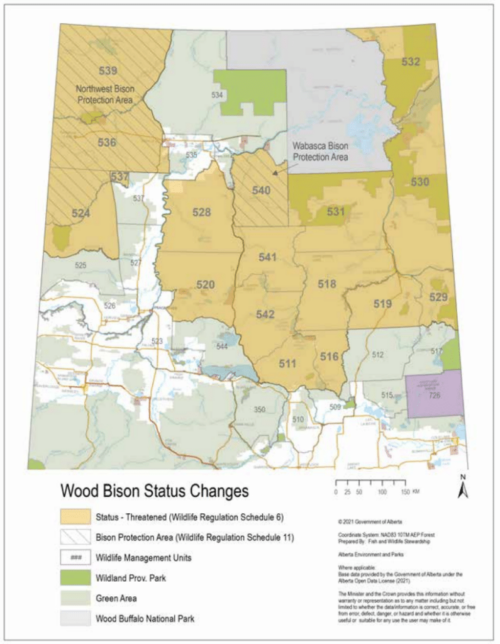Wildlife Status for Wood Bison – Righting A Historical Wrong
November 15, 2021
ᐊᒥᐢᑲᐧᒋᐊᐧᐢᑲᐦᐃᑲᐣ amiskwacîwâskahikan (Edmonton), AB – The Government of Alberta has announced that wood bison in northern Alberta are officially a Threatened species, providing them protections under the Wildlife Act and recognizing them as ‘wildlife’. With fewer than 3,000 wild wood bison left in the province, CPAWS (Canadian Parks and Wilderness Society) Northern Alberta celebrates this critical step towards the conservation of this iconic animal.
“Many Albertans are shocked to learn that until now, wild wood bison were not considered wildlife on provincial lands,” says Kecia Kerr, Executive Director with CPAWS Northern Alberta. “Wild wood bison herds used to be managed on a one-by-one basis, resulting in important herds falling through the cracks. These regulations should help close that gap.”
Listing wood bison as a Threatened species will provide necessary immediate protections through regulation of hunting. Historically, there have been no regulations for hunting wild wood bison, except in specific locations for the Hay Zama and Ronald Lake herds. Unregulated hunting is a strong driver of decline for the Wabasca herd, found just southwest of Wood Buffalo National Park. Recent counts estimate there are fewer than 15 animals left in the Wabasca herd. As such, Alberta has created a Wabasca Bison Protection Area, which will protect this herd from all hunting.
“Updating Alberta’s antiquated regulations is a step in the right direction,” says Gillian Chow-Fraser, Boreal Program Manager. “All communities in Alberta will benefit from protections for wild wood bison—they have irreplaceable ecological, cultural, and economic value.”
CPAWS hopes the new wildlife status will pave the way for progressive conservation actions, including the potential need to repopulate dwindling wild herds to prevent extirpation. Habitat protections will be necessary to ensure that the herds can recover, become self-sustaining, and provide food security to Indigenous communities.
The regulatory change is the result of decades of advocacy by many people and organizations, including Indigenous Elders that make up ShagowAskee, and past and present leadership of Little Red River Cree Nation and other northern First Nations.
CPAWS looks forward to collaborating with the Government of Alberta and Indigenous communities to ensure wild wood bison remain an important part of Alberta’s boreal landscape.

For more information:
Gillian Chow-Fraser, 289-775-3250, [email protected]
Government of Alberta Wood Bison Regulation
CPAWS NAB Bison Conservation in Alberta
Previous media coverage: Little Red River Cree Nation trappers in Alberta worry that Wood Bison herd may disappear
Make a donation
Move conservation forward in Alberta.
Lasting protection for nature and wildlife in Alberta doesn’t happen overnight (although we wish it did)! Your donation fuels our fight for nature. Donate to support CPAWS Northern Alberta’s conservation efforts.
